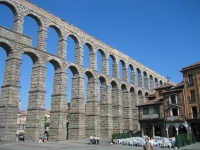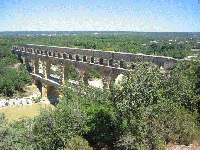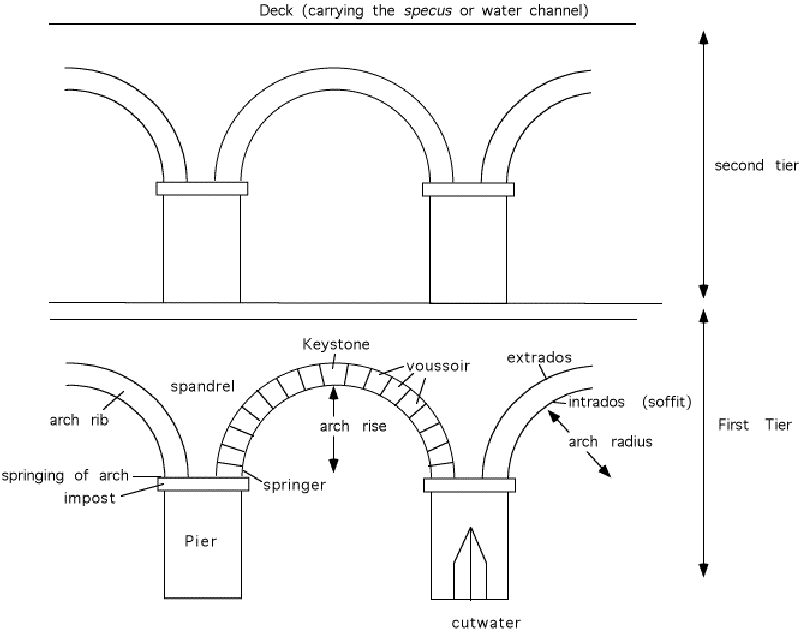


Note
Sometimes there is confusion about the word 'aqueduct':
an aqueduct is a channel or pipe-line to transport water. Often 80% of its course is subterranean.
To cross a river or depression an aqueduct bridge is used.
Bridges
According to O'Conner (1993:151), the total length of the aqueducts at Rome was 507 kilometres. 434 underground, 15 on the surface and 59 on bridges. This makes only 11.6% on bridges, unless you take into account that some briges counted for more than one channel, so the total is closer to 5%.According to O'Conner (1993:203) only six of the eleven Roman aqueducts have significant remains of bridges. These are the Marcia, Tepula, Julia, Claudia, Anio Novus and Alexandrina. The most impressive remains of aqueduct bridges span the valleys and ravines between Tivoli and the Alban Hills, in the area between the modern town of Gallicano nel Lazio and the village of S. Vittorio (Aicher, 1995:113).
One of the most important, and impressive, remaining bridges in the area of Rome is the Ponte Lupo, just south of the road to Poli. It is a massive and confused mass of original stone and concrete repair, 115 metres long and 30 metres tall. The evidence show that this bridge carried the Aqua Marcia. Van Deman (1934) provides a succinct summary of the bridges history.
This colossal structure, an epitome in stone and concrete of the history of Roman construction for almost nine centuries, is composed of two lofty arches of early cut-stone over the stream with heavy abutments of Augustan concrete on both banks, enclosed, but a few years later, in walls of concrete of the same general type, which, in their turn, were reinforced by massive walls at least three times in as many centuries, with extensive later repairs.The Ponte Lupo was originally built in 144 BC out of cut-stone quarried from the tufa slopes on the valley's left bank near the bridge. The only remains of the structure are the two tall arches that are clearly visible at the stream. A century later the bridge had deteriorated badly enough to necessitate almost complete replacement. Agrippa, rather than shoring up the original structure, replaced all but the two central stone archways. Agrippa's engineers were the first in Rome to use concrete in the construction of
 |
| The original version of the Anio Vetus bridge crossing the Fosse de Mola stood downstream of the present bridge. Hadrian made a short-cut
in the route with the Ponte S. Gregorio bridge (Rome - Anio Vetus). This type of arrangement was described by Frontinus (18.5): "But now, whenever a conduit is beyond repair because of its age, in certain places, to save length, the circuitous underground route is abandoned and substructures and arches are used to cross valleys". (translation from R.H. Rodgers 2003). Drawing from Ashby 1935. |
There was a limit to the height to which the Romans built the arches over which aqueducts were carried. It is possible for a tall pillar to fold sideways in the middle during a high wind or if subsidence had taken place a the base. If one pillar gave way, it could cause a progressive collapse of the whole series of arches. The Roman solution was to limit the height of the arches to about 21 metres. When they worked near this limit they made the pillars very massive, and the arches between them narrow. If a greater elevation was required, the Romans built the arches in two tiers, the pillars of the upper resting directly on those of the lower. The arches of the lower tier could me made simple and not very heavy, their sole purpose being to brace the pillars from each side. They consisted of the solid wedge-shaped stones which formed the arches themselves and shaped stone forming a level top course above the arch. The structure above the upper tier was exactly like that on a single-tier aqueduct (Landels, 2000:47).
When the aqueduct had to cross a deep valley, for some reason the engineers had decided not to use a siphon, and than the same principle (multi tiers) might been used. This technique does not appear to have been used near Rome, probably because it was not necessary to do so.
The most famous examples of aqueduct bridges are the ones in Segovia (Spain) with two tiers and the well-known Pont du Gard with thee tiers of arches carrying a stage (see photo's and links above). But not less impressive are the bridges in Ililouine (Algeria) and Merida (Spain). The image of the Pont du Gard was even used on the European banknote of 5 euro.
Terms
 |
Crossing the Tiber in Rome
According to Taylor (2002), only one of the bridges that crossed the Tiber carried an aqueduct exclusively, the Pons Traiani. Until 109 AD, when the Aqua Traiana was built, most of the water in the Transtiberim (the west side of the Tiber) had to be supplied from the east bank by means of inverted siphon carrying pressurised water in pipes across existing bridges. The most notable of these was Agrippa's Aqua Virgo and Nero's Claudia-Anio Novus system from the western Caelian hill. When Frontinus was writing in the late first century AD three other systems also fed the Transtiberim, namely the Aqua Appia, the Anio Vetus and the Aqua Marcia. These crossings may initially have been the work of Agrippa, who as aedile in 33 BC had restored and expanded the water system throughout Rome. In the following decades a number of new water sources became available, including new branches of the Aqua Appia and the Aqua Marcia, new aqueducts in the form of the Aqua Julia, Aqua Virgo and the specialised Aqua Alsietina. When possible, the river crossings were probably added to existing bridges. The distribution point of the Aqua Appia was at the Porta Trigemina in the Salinae, making the likely crossing to have been on the Pons Aemilius. The crossing sites of the Anio Vetus and the Aqua Marcia are less certain, but there are few options. The Pons Cestius might have been built by order of Agrippa to help carry his planned load of aqueduct siphon pipes. The funerary inscription of C. Cestius indicates that he was a partisan of Augustus. Doubtless Agrippa built the Pons Agrippae with a similar purpose in mind. There is evidence that the Aqua Virgo crossed the Tiber on this bridge (Taylor, 2002:16). It can only be a matter of conjecture which bridges the other aqueducts used, but it is likely that the largest (for example, the Claudia-Anio Novus) had multiple crossings on whatever bridges were available.The reference to the Pons Traiani appears only once, in a late source (Taylor, 2002:17). It is usually taken as a mistaken reference to the Pons Aelius, the bridge Trajan's successor Hadrian built. Taylor has argues that the Pons Traiani is a separate bridge and can be identified on maps of the early modern period. Taylor's view is that it was exclusively an aqueduct crossing and offered no transit for traffic. It is for this reason that it is not included in the various extant lists of traffic bridges. As the Pons Traiani would have served as the support for a free-flow channel of water it would have been more prominent than its neighbours, rising (in Taylor's view) perhaps as high as 35 metres above the surface of the water. The ruins of bridge piers that plausibly may have been the Pons Traiani appear in a map by G.-B. Nolli in 1748, and are reproduced in a map by Lanciani.
According to Taylor (2002:17) the Pons Traiani bore the Aqua Traiani across the Tiber. This was the sixth and last aqueduct to cross the Tiber, and the only one to cross from west to east, as unlike most of the aqueducts, it arrived in the city from the west. There is epigraphic evidence that the Aqua Traiani served the entire city. As most of Rome's population was on the east bank, it is sensible that Trajan's engineers would build a free-flow channel across a river instead of using a siphon pipe; the volume of water would make using siphons problematic.
From the thesis of Evan J. Dembskey on The aqueducts of Ancient Rome